The Saints and Their Feast Days
–
Introduction
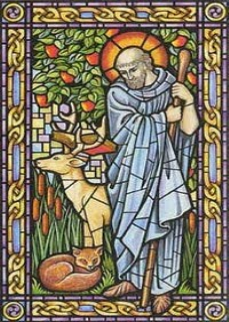
During the first 1,000 years of the Christian Church there were many saints who loved animals. They lived with them, rescued them, nursed them and saved them from hunters. In turn, many saints were helped by animals.
We have listed some of these saints below in order of their feast days. We hope that the information on them is useful and that you can ask your priest to remember them during services on their feast days for their love of animals.The Saints and Their Feast Days
St Basil the Great: Feast Day – 2 January
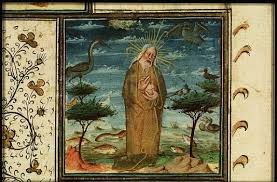
St Basil (330 AD – 379 AD) greatly influenced the Eastern Church and said in this prayer in the ‘Liturgy of St Basil’:
‘The Earth is the Lord’s and the fullness thereof. O God, enlarge within us the sense of fellowship with all living things, our brothers the animals to whom thou has given the earth as their home in common with us. We remember with shame that in the past we have exercised the high dominion of man with ruthless cruelty, so that the voice of the earth, which should have gone up to Thee in song, has been a groan of travail. May we realise that they live, not for us alone, but for themselves and for Thee, and that they love the sweetness of life.’
St Anthony Abbot: Feast Day – 17 January
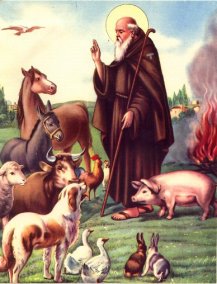
St Anthony Abbot (251 AD – 356 AD) lived as a hermit in Egypt and was followed around by a pig whose illness he had cured.
St Gertrude of Nivelles, Patron Saint of Cats – 17th March

St Gertrude of Nivelles (626 AD – 659 AD) was the patron saint of cats and also gardeners, travellers and widows. She was born into a noble family who lived at King Dagobert’s court in Belgium, where her father served as mayor of Dagobert’s palace. When Gertrude was 10 years old, King Dagobert tried to arrange a marriage between her and the son of an Austrian duke in order to form a political alliance, but Gertrude refusSt Gertrudeed to marry him because she wanted to become a nun in the church instead, saying that she would only be married to Jesus Christ.
Gertrude did become a nun, and she worked with her mother to start a monastery at Nivelles, Belgium, where they both served as co-leaders. Gertrude helped build new churches and hospitals, and she took care of travellers and local people in need (such as widows and orphans). She also spent lots of time in prayer vigils. Gertrude was known for offering hospitality to animals as well as people. She was kind to the cats that hung around her monastery, offering them food and affection.
St Cuthbert: Feast Day – 20 March
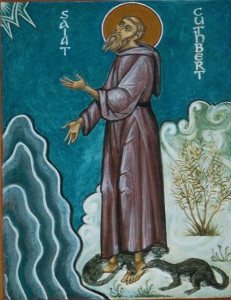
St Cuthbert (634 AD – 687 AD) was a Scottish shepherd boy until he was fifteen, when he became a monk in Melrose Abbey. Later, he became a hermit, living on Farne Island in a small cell. There he made friends with the birds, giving them his protection from hunters and sharing meals with them. He is the patron saint of otters, and after standing waist-deep in the North Sea during his nightly prayer vigils, two otters would come and warm his feet.
St Philip Neri : Feast Day – 26 May
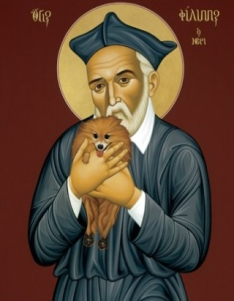
St Philip Neri (1515 AD – 1595 AD) was an unusually late saint to be concerned with animals. Although he is best known as the founder of the Oratory Movement, he embraced vegetarianism on the grounds of animal welfare, not just on the grounds of abstinence. Once, passing a butcher’s shop he said, ‘If everyone was like me, they wouldn’t kill animals’. He also set captive birds free which, by their own choice, would not leave him. Animals were attracted to him. At one time, someone found a young bird in the chapel and brought it to him. Philip told them not to squeeze the bird or hurt it, but to open the window and let it fly away. But afterwards he worried whether he had done the right thing, as it was so small that it wouldn’t know where to go. On another occasion he was given a brace of live partridges for a meal, but he set them free. He would also insist on flies being let out of the window instead of being swatted. He released captured mice into places of safety and expressed pity for animals on their way to slaughter. He cared for humans as well as for animals and saved an ex-Dominican heretic from execution.
St Melangell: Feast Day – 27 May
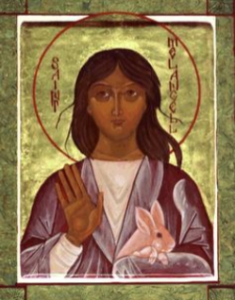
St Melangell is the Welsh patron saint of animals. In 604 AD the Prince of Powys, Brochwel Ysgithrog, went hare hunting at Pennant in the Derwyn Hills. His hounds pursued their prey into a bramble thicket and, following them, he found a young woman praying and given up to divine contemplation, with the hare lying under the fold of her garments. The baying hounds also came under her calming influence and the exasperated prince gave up the chase and sat to listen to her story of escape and exile from Ireland. Impressed by her piety and courage, he made a vow to present her with his lands for the service of God, that they might be a perpetual asylum, refuge and defence. Melangell lived there as a solitary for 37 years, after which a church with a shrine was built over her cell. Her church remained a place of sanctuary throughout the Middle Ages and the hares continued to be protected in the parish. The conservation society, Cymdeithas Melangell, now promotes animal welfare
St Hubert: Feast Day – 30 May
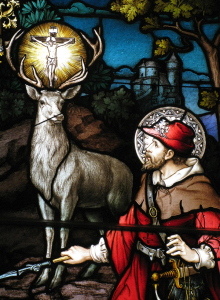
St Hubert (c 656 – 727 AD) is inaccurately known as the patron saint of hunters. As the legend tells, he lived in a forest in the Ardennes as a hunter. One Good Friday, when every one else was at Church, he was hunting in the forest, pursuing a magnificent stag. Suddenly, as the stag turned round, a crucifix appeared between his antlers and a voice said, ‘Hubert, unless you turn to the Lord and lead a holy life, you shall quickly go down to hell’. Hubert dismounted his horse and prostrated himself, saying, ‘Lord, what would You have me do?’ and the reply came, ‘Go and seek Lambert and he will instruct you’. Hubert then went to Bishop Lambert who became his spiritual guide. Hubert gave all his wealth to the poor and studied for the priesthood, living a holy life, fasting and praying. Eventually he became Bishop of Liege in 708 AD.
St Hubert later became honoured by sportsmen as the originator of ethical hunting behaviour, although he renounced hunting after he had his vision. In fact, his hunting life had been seen by God as an unholy life, which would lead him to hell.
St Petroc – 4th June
St Petroc is Cornwall’s most famous saint and early hunt saboteur. Petroc is said to have been the son of a Welsh chieftain. He studied in Ireland before settling in Cornwall in the 4th century.
Petroc founded a monastery at what is now called Padstow (Petroc’s Stow). About 30 years later he established another monastery at Little Petherick, where he built a mill and a chapel. In his last years, Petroc lived as a hermit on Bodmin Moor. He built a cell there for himself by the river and a monastery for twelve monks who followed him.
St Petroc died at Treravel while on a journey visiting his other monasteries. He was buried at Padstow which became the centre of his cult.
His relics were later moved to Bodmin where they remain to this day. In 1177 a disgruntled canon took them off to the abbey of St Mewan in Brittany. Thanks to the intervention of King Henry II they were returned to Bodmin amidst great celebrations. This event has been revived as part of the Bodmin Riding and Heritage Festival. The actual reliquary survived the Reformation and the destruction of the shrine.
Petroc was greatly revered for centuries throughout Cornwall and Brittany, (where he is known as St Perreux). The saint had a special affinity with wild animals. One of his emblems is a stag – in memory of one he rescued from hunters. According to legend he also once tamed a dragon.
Ref ICN – St Petroc | ICN (indcatholicnews.com)
St Columba: Feast Day – 9 June
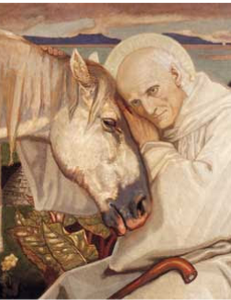
St Columba (521 AD – 597 AD) started life as a child of a royal family in Ireland. In 563 he climbed into a flimsy boat with twelve monks and set out to sea, unsure of his destination. They landed on the barren island of Iona, off the coast of Scotland, where they founded a monastery which would become the virtual centre of Celtic spirituality. Columba lived on Iona for more than thirty years, copying manuscripts and making missionary journeys to Scotland. Life on the island mellowed his once fiery temper and replaced it with a calm and gentle spirit.
The following is taken from Adamnan of Iona’s Life of St Columba, and tells the tale of a horse’s understanding of the impending death of the Saint.
After this the saint left the barn, and in going back to the monastery, rested half way at a place where a cross, which was afterwards erected, and is standing to this day, fixed into a millstone, may be observed on the roadside. While the saint, as I have said, bowed down with old age, sat there to rest a little, behold, there came up to him a white pack-horse, the same that used, as a willing servant, to carry the milk-vessels from the cowshed to the monastery. It came up to the saint and, strange to say, laid its head on his bosom, inspired, I believe, by God to do so, as each animal is gifted with the knowledge of things according to the will of the Creator; and knowing that its master was soon about to leave it, and that it would see him no more, began to utter plaintive cries, and like a human being, to shed copious tears on the saint’s bosom, foaming and greatly wailing. The attendant seeing this, began to drive the weeping mourner away, but the saint forbade him, saying: ‘Let it alone, as it is so fond of me, let it pour out its bitter grief into my bosom. Lo! thou, as thou art a man, and hast a rational soul, canst know nothing of my departure hence, except what I myself have just told you, but to this brute beast, devoid of reason, the Creator Himself hath evidently, in some way, made it known that its master is going to leave it’. And saying this, the saint blessed the work-horse, which turned away from him in sadness.
St Neot: Feast Day – 31 July
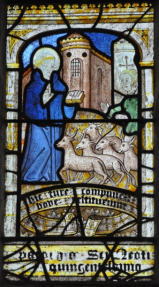
St Neot (died around 870 AD ) is credited with rescuing a deer.
St Roche: Feast Day – 16 August
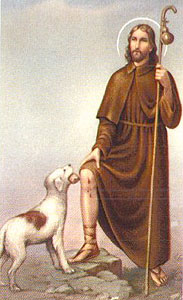
St Roche (1295 AD -1327 AD) is the patron saint of ailments and dogs. He was born in Montpellier, then on the France/Italy border, in 1295 as the son of a nobleman and governor of the city. His mother had tried unsuccessfully to give birth for many years, but she prayed to the Virgin Mary to have a child and Roche was conceived. His birth was, therefore, seen to be a miracle and he had a birthmark of a cross on his breast which grew as he grew. His mother was a pious woman who led a holy life and regularly fasted, and the young Roche loyally followed her example of asceticism.
When Roche was twenty, both his parents died and he inherited his father’s title and wealth but he gave everything away to the poor and, following the example of St Francis of Assisi, lead an ascetic life, looking after the poor and the sick. He left for Rome and administered to the sick in the hospitals there and in the surrounding towns. Unfortunately, whilst caring for people with plague in the town of Piacenta, he contracted the disease himself and fell very ill. He was thrown out of the town and went to live in the forest where he obtained water from a spring but had no food. As no human would approach him, he would have died had it not been for a dog which brought him bread every day and licked his wounds. Eventually, Roche recovered and continued his work until he returned to Montpellier where he was thrown into prison by his uncle in 1322 for being a spy. He died there on 16th August 1327 and was canonised in 1590.
The feast day of St Roche, on 16 August, is often celebrated with a dog blessing service to give thanks for the companionship of dogs who support old, sick, blind, deaf and lonely people.
St Giles: Feast Day – 1 September

St Giles (650 AD – 710 AD) lived in solitude in the forest of Nimes where he ate a vegetarian diet and where his sole companion was a red deer. The King’s hunters chased the deer to her refuge with Giles. When they shot an arrow at her, they hit and wounded Giles instead who later became patron of cripples.
St Ciaran the Younger: Feast Day – 9 September
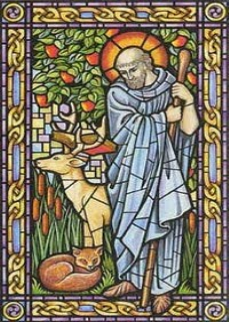
St Ciaran of Ireland (516 AD – 544AD) was converted to the Christian faith by St Patrick and began to preach to the Irish people, who were then mostly pagans. One day, feeling the need for a period of quiet, Ciaran went to a lonely woodland district and started to build himself a cell. Sitting down by a tree, he noticed a fierce looking boar. Ciaran spoke gently to the boar calling him ‘Brother Boar’, as he treated all animals as his brother and sister. The boar realised that Ciaran was a friend and not a foe and so he helped Ciaran to build his cell, tearing down strong branches with his teeth and bringing them to Ciaran. When the cell was finished the boar stayed with Ciaran and soon many other animals joined them, including a wolf, a fox, a badger, a deer and many birds. Ciaran called them all the first brother monks of his little monastery. Later, as people joined them and Ciaran started a larger monastery, he never forgot his animal friends who continued to live with him.
St John Chrysostom: Feast Day 13 September
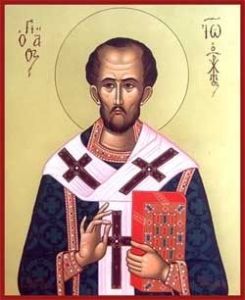
St John of Chrysostom (347 AD – 407 AD) who had been a powerful influence in the Byzantine Church, said,
‘The Saints are exceedingly loving and gentle to mankind and even to brute beasts… Surely we ought to show them great kindness and gentleness for many reasons, but above all, because they are the same origin as ourselves.’
St Jerome: Feast Day – 30 September
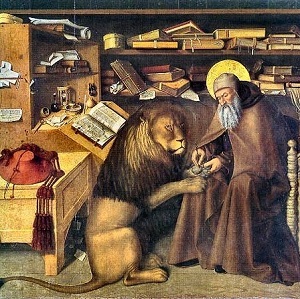
St Jerome (373 AD – 420 AD) took a thorn from the paw of a lion who repaid him by giving up eating other animals and serving at the monastery until he joined St Jerome in death.
St Francis of Assisi: Feast Day – 4 October

St Francis of Assisi (1181 AD – 1226 AD) is known as the Patron Saint of Animals and is commonly thought to be the main saint who showed concern for animals. But, as we have seen, he was not alone. A great many of the saints before him, particularly those who lived a solitary and ascetic life, bestowed compassion on animals, returning to the spiritual state man had been in when he resided in the Garden of Eden, communicating with animals and living in harmony with nature.
St Francis was famously known to preach to the animals and he is reputed to have persuaded a wolf to stop attacking the town’s people of Agobio if those people promised to feed the wolf for the rest of his life. Francis was a radical who broke away from traditional monastic life and founded a group of itinerant preachers which, in 1209, was given papal approval. For Francis, the divine was in everything in nature, such as the sun, the moon, mountains, wind and water and, of course, in animals. He called everything his ‘brother’ or ‘sister’, such as ‘Brother Sun’ and ‘Sister Moon’.
St Francis said,
‘Not to hurt our humble brethren is our first duty to them, but to stop there is not enough. We have a higher mission to be of service to them wherever they require it.’
‘If you have men who will exclude any of God’s creatures from the shelter of compassion and pity, you will have men who will deal likewise with their fellow men.’
This great sense of the interconnectedness and interrelatedness of things was expressed in his famous:
The Canticle of Brother Sun or Praise of the Creatures:
Most high, omnipotent, good Lord,
Praise, glory, and benediction, all are Thine,
To Thee alone do they belong, Most High,
And there is no man fit to mention Thee.
Praise be to Thee, my Lord, with all Thy creatures,
Especially to my worshipful brother sun,
The which lights up the day, and through him dost Thou brightness give;
And beautiful is he and radiant with splendour great;
Of Thee, Most High, signification gives.
Praised be my Lord, for sister moon and for the stars,
In Heaven Thou hast formed them clear and precious and fair.
Praised be my Lord for brother wind,
And for the air and clouds and fair and every kind of weather,
By the which Thou givest to Thy creatures nourishment.
Praised be my Lord for sister water,
The which is greatly helpful and humble and precious and pure.
Praised be my Lord for brother fire,
By the which Thou lightest up the dark,
And fair is he and gay and mighty and strong.
Praised be my Lord for our sister, mother earth,
The which sustains us and keeps us
And brings forth diverse fruit with grasses and flowers bright.
Praised be my Lord for those who for Thy love forgive,
And weakness bear and tribulation.
Blessed those who shall in peace endure,
For by Thee, Most High, shall they be crowned.
Praised be my Lord for our sister, the bodily death,
From the which no living man can flee.
Woe to them who die in mortal sin,
Blessed those who shall find themselves in Thy most holy will,
For the second death shall do them no ill.
Praise ye and bless ye my Lord and give Him thanks,
And be subject unto Him with great humility.
St Martin de Porres – 3rd November
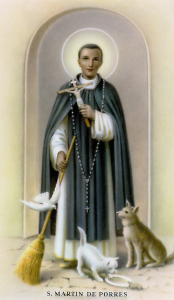
St Martin de Porres (1579-1639) was born in Lima, Peru as the illegitimate son of a Spanish gentleman and a freed African slave woman. Abandoned by his father at a young age, he lived a life of poverty and was also ridiculed for being of mixed race. He lived a life of fasting, prayer and abstaining from meat and was only allowed to join a monastery (as a Dominican) by accepting the menial tasks. He grew famous for his humility, for caring for the sick, for performing miracles and for his love of animals and for being able to communicate with them and heal them. He lived with a dog, a cat, a bird and a mouse.
St Edmund: Feast Day – 20th November
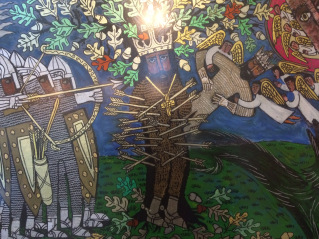
Edmund was king of East Anglia from 855 AD until his death on 20 November 869 AD. His kingdom was attacked by Vikings who wanted Edmund to renounce his Christian faith. When he refused to do so, they captured him, tied him to a tree and shot him with arrows. They then beheaded him and threw his head into the forest, preventing him from having a Christian burial with his whole body together. Distressed by this, his loyal followers went in search of Edmund’s head so that it could be reunited with his body for burial. Hearing a wolf crying what sounded like ‘Hic, hic, hic’ which is the Latin for ‘Here, here, here’, they followed the sound and found a wolf guarding Edmund’s head. Edmund’s followers were then able to reunite his head with his body and give him a Christian burial.
A shrine was made to Edmund at Bury St Edmunds in Suffolk which was visited by many kings and pilgrims. Abbo of Fleury wrote about his life and martyrdom in about 986 AD and it is referred to in the Anglo-Saxon Chronicle. Known as Edmund the Martyr, his feast day is 20th November.
St Modestos: Feast Day – 18th December

St Modestos (537 AD – 634 AD) was Archbishop of Jerusalem from 631 AD – 634 AD. He was famed for being a healer of animals. To this day, it is said, that anyone who celebrates the memory of St Modestos, with faith, will have protection for their animals from all harm.
St Modestos is now remembered as the patron saint of farm animals in Greece, which is unfortunate, as this saint would not eat animals, as is suggested in the words of his prayer for animals.
St Modestos’ Prayer for Animals
(Specifically for animals who are sick or in danger)
O Lord Jesus Christ my God, Who are merciful and All-good, Who in wisdom created every visible and invisible creature, Who pours out His compassions upon all that He has created, Who through Your all-good Providence foresees and troubles over for all Your creatures: bodiless, physical, rational, irrational, soul-bearing, soulless, from the first to the last. For nothing is not foreseen by You, neither is anything abandoned by You, the Creator and Foreseer of all. For You are He Who opens His hand, and fills all living things with goodness. You are He makes grass to grow for the cattle, and green herb for the service of men. You are He Who once, through the herd of Israel, preserved them from above from the fatal wound of the first-born of the Egyptians. You are He Who, through the compassion of Your incarnation, deposed he who had the might of death: that is, the devil, and by Your death, You put death to death.
You are He Who, through myself Your unworthy servant, puts to death the serpent, that Your spring of water might not be corrupted. Those that drink from it, both the living and the dead, through Your life-giving power, you resurrect. And if a demon draws near to it, and prepares to make itself apparent, seize it, that it might never dare to approach the place in which, I the sinner, call upon Your name. To You, therefore, I pray, O All-good Master and Creator of all, and I entreat You, the cause of all life, hearken to this my entreaty, and drive away every fatal sickness and danger from the oxen, horses, donkeys, mules, sheep, goats, bees, and any other animals in true need to the life of Your servants who call upon You, the giver of every good, and of my name. And grant, O Lord, to all those who celebrate my name, and with faith hasten to my relics, permanent peace, multiplication of animals, uncorrupted wheat, wine and oil, and above all, remission of sins, health of bodies, and eternal salvation of souls.
Yes, O Lord Jesus Christ, for the descendants from Your very loins, grant compassion on the suffering animals, whose herd is being afflicted by the sickle of death. And not having any word besides bleating, and bitter and random noises, in Your mercy, take away their passion and suffering. For if You even call rational beings to this sympathy: “A righteous man has compassion upon his animals”, as is written, how much more do You show compassion on these, Who are their Creator and Foreseer? For You, O compassionate, preserved the animals in the Ark, as Your goodness and compassions won out. That by the wellness and multiplication of the oxen, and the remaining four-legged animals, the earth might be worked, and fruit might be harvested, and Your servants who call upon my name might be preserved without any corruption, and partake of their very harvest. And that these, having all things that are necessary, might be increased in every good work, and glorify You, Who grants every good thing. And grant me also, Your servant and most-fervent entreater, the honour of Your all-governing Kingdom, for to You belong all glory, honour and worship, with Your beginningless Father, and Your All-Holy and good and life-giving Spirit, now and ever, and unto the ages of ages.
Amen.
St Sylvester: Feast Day – 31 December

St Sylvester (died in 335 AD ) was Pope from 314 AD until his death. He is credited with caring for a bull.



Comments are closed.